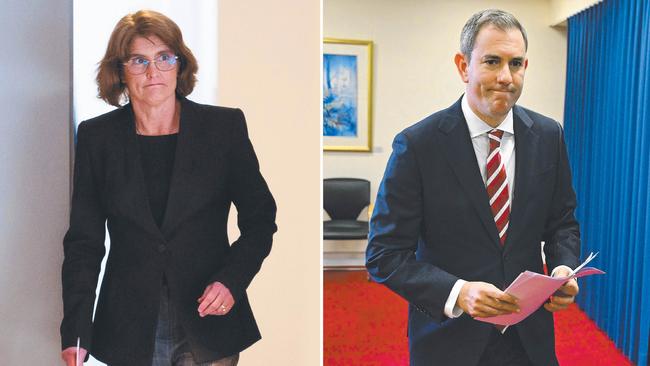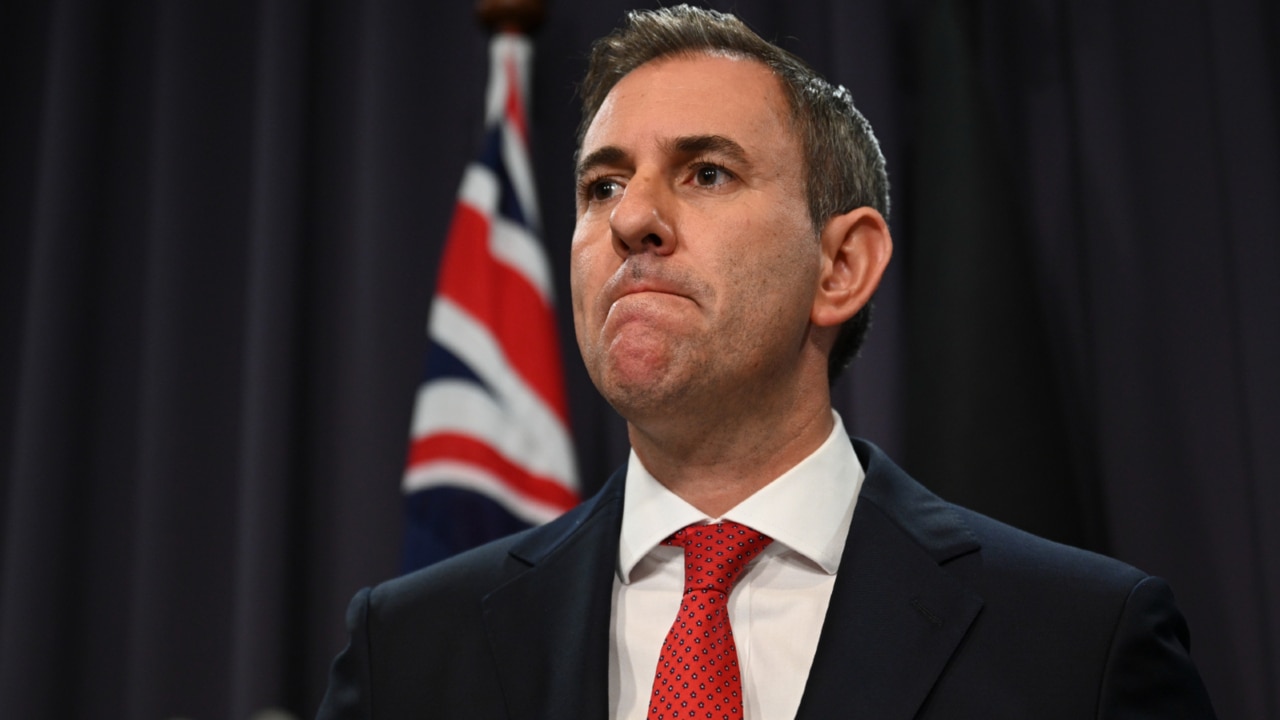RBA governor Michele Bullock says government spending is keeping inflation high
Reserve Bank governor Michele Bullock reveals ‘very serious’ consideration was given to a hike on Tuesday, with the central bank acknowledging government spending was keeping inflation higher for longer.

Reserve Bank governor Michele Bullock has pushed back the prospect of interest rate cuts until next year and revealed “very serious” consideration was given to a hike on Tuesday, with the central bank acknowledging that government spending was keeping inflation higher for longer.
In a blow to Jim Chalmers’ claim his budget strategy was making the RBA’s job easier, the central bank increased its underlying inflation forecasts and made clear Labor’s energy rebates would not lead to a faster reduction in the 4.35 per cent cash rate.
The RBA’s latest quarterly statement also revised up economic growth forecasts, saying the stronger outlook was fuelled by “ongoing spending and recent announcements by federal and state and territory governments”.
“Make no mistake: inflation is still too high, and the board does remain concerned about the degree of excess demand in the economy,” Ms Bullock said at a news conference after the rates decision was announced.
“What we can say is that a near-term reduction in the cash rate doesn’t align with the board’s current thinking.
“I understand that this is not what people want to hear.”
Asked to define what she meant by “near term”, Ms Bullock replied: “By the end of the year, in the next six months.”
Financial traders were still betting on a rate cut by the end of the year but most economists predicted mortgage holders would need to wait until 2025 for relief.
The Treasurer welcomed the RBA’s decision to keep interest rates on hold, saying it recognised the cost-of-living pressures on families and “the progress we’ve made on underlying inflation”.

Dr Chalmers said the decision recognised the volatility in global markets, despite Ms Bullock playing this down as an influence.
“It wasn’t that long ago that people were calling for much higher interest rates, and I think what we’ve seen here is a welcome outcome because it recognises that we can continue the fight against inflation without smashing our economy,” he said.
Dr Chalmers claimed the government’s policies were making the RBA’s job easier, boasting that Labor’s cost-of-living subsidies were forecast to drive headline inflation below 3 per cent in the next year. But the RBA forecast headline inflation to rise from 2.8 per cent in June next year to 3.7 per cent in December when the energy rebates ended.
Opposition Treasury spokesman Angus Taylor said it was a concern the RBA had “extended the timeframe it’s going to take to get back to the target level of inflation”.
“We heard before the budget, the Treasurer tell us that the Reserve Bank has got their forecast completely wrong because they hadn’t seen the budget,” Mr Taylor said.
“Well, they’ve seen the budget now, and they’ve increased their forecasts for inflation, and they’ve said it’s going to take longer to get back into the range and to get back to target.”
With the RBA keeping rates on hold at 4.35 per cent, Ms Bullock signalled that stronger government spending, a resilient labour market and an expected pick-up in household consumption – fuelled by stage three tax cuts – were all factors behind new figures showing inflation would take longer to return to the middle of the 2-3 per cent target band. The RBA’s quarterly statement on monetary policy revealed the central bank’s economists were far more hawkish about the outlook for inflation and interest rates than the market consensus.

“Relative to three months ago, GDP growth has been revised up in the year to mid-2025,” it said. “The stronger outlook for public demand reflects ongoing spending and recent announcements by federal and state and territory governments.”
In May, the bank forecast public demand growing by 2.1 per cent by June next year, but on Tuesday updated that estimate to 4.1 per cent over the same period.
Independent economist Chris Richardson said the RBA statement was about as “clear as they can be”. “There is extra budget spending in the system,” he said. “And that is part of making the economy bigger, but the fight against inflation a little slower.”
Mr Richardson said that governments were “pretending they have solved the inflation problem with their subsidies”.
“But the Reserve Bank is focusing on underlying inflation and (that is forecast to be) slightly worse than it was three months ago,” he said.
The statement on monetary policy showed that underlying inflation was now forecast to be running at 3.5 per cent in December – an increase on the May forecast when the bank had projected 3.4 per cent. “Underlying inflation is forecast to return to the target range of 2–3 per cent in late 2025 and approach the midpoint in 2026,” the central bank said. “This is a slightly slower return to target than forecast in May and is due to greater inflationary pressures in the economy. In part, this owes to a stronger outlook for domestic demand, led by higher public demand.”
Headline inflation is not projected to return to the middle of the target band at any point over the central bank’s forecast horizon. The RBA forecast it would still be running at 3.2 per cent in June 2026 – a major lift on the May forecast when it projected 2.6 per cent – before moderating to 2.6 per cent by December 2026.
While headline inflation is forecast to drop to 2.8 per cent in June next year – driven by the impact of the Treasurer’s energy subsidies – the RBA expects it to rise swiftly to 3.7 per cent by December.
Steven Hamilton, assistant professor of economics at George Washington University and a visiting fellow at the ANU, said the government’s energy subsidies “do not lower inflation but simply shift it through time”.
“Inflation is far higher next year as a result,” he said.
Judo Bank chief economist Warren Hogan said the central bank was “allowing inflation to linger in our economy for longer”.
Ms Bullock said raising rates was a “very serious consideration” in this week’s meeting. “There were two things on the table: hold – accepting that we might have to hold for some time – or raise”.



To join the conversation, please log in. Don't have an account? Register
Join the conversation, you are commenting as Logout